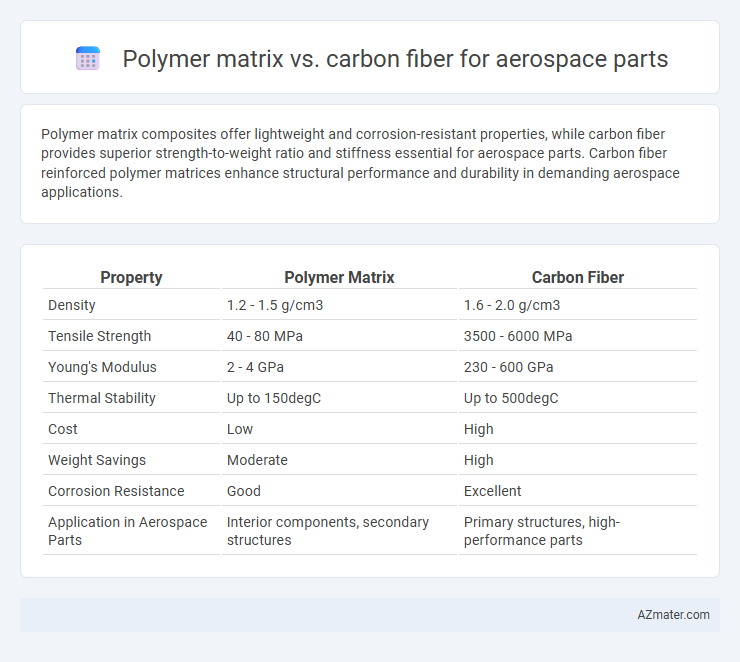Polymer matrix composites offer lightweight and corrosion-resistant properties, while carbon fiber provides superior strength-to-weight ratio and stiffness essential for aerospace parts. Carbon fiber reinforced polymer matrices enhance structural performance and durability in demanding aerospace applications.
Table of Comparison
| Property | Polymer Matrix | Carbon Fiber |
|---|---|---|
| Density | 1.2 - 1.5 g/cm3 | 1.6 - 2.0 g/cm3 |
| Tensile Strength | 40 - 80 MPa | 3500 - 6000 MPa |
| Young's Modulus | 2 - 4 GPa | 230 - 600 GPa |
| Thermal Stability | Up to 150degC | Up to 500degC |
| Cost | Low | High |
| Weight Savings | Moderate | High |
| Corrosion Resistance | Good | Excellent |
| Application in Aerospace Parts | Interior components, secondary structures | Primary structures, high-performance parts |
Introduction to Aerospace Materials
Polymer matrix composites and carbon fiber composites are critical materials in aerospace applications due to their high strength-to-weight ratios and corrosion resistance. Polymer matrix composites, typically reinforced with carbon fibers, offer enhanced durability and flexibility essential for aerospace structures. Carbon fiber composites outperform traditional metals by providing superior stiffness and fatigue resistance, making them ideal for lightweight aircraft components.
Overview of Polymer Matrix Composites
Polymer matrix composites (PMCs) consist of a polymer resin reinforced with fibers such as carbon, glass, or aramid, offering a lightweight and corrosion-resistant solution ideal for aerospace applications. These composites provide high strength-to-weight ratios, excellent fatigue resistance, and design flexibility, making them preferable for structural aerospace parts requiring durability under varying stresses. The thermosetting polymers used in PMCs allow for stability at elevated temperatures, which is crucial for parts exposed to harsh aerospace environments.
Basics of Carbon Fiber in Aerospace
Carbon fiber is a high-strength, lightweight material widely used in aerospace for its superior strength-to-weight ratio and excellent fatigue resistance. It consists of thin carbon filaments bonded with a polymer matrix, typically epoxy, providing enhanced structural rigidity and thermal stability. These properties make carbon fiber composites ideal for critical aerospace components, reducing overall aircraft weight and improving fuel efficiency.
Mechanical Strength Comparison
Carbon fiber composites exhibit significantly higher tensile strength and stiffness compared to polymer matrix materials, making them the preferred choice for aerospace parts that require superior mechanical performance. The high strength-to-weight ratio of carbon fiber enhances load-bearing capacity while reducing overall component weight, critical for aircraft efficiency and fuel savings. Polymer matrix materials, while easier to process and more cost-effective, generally offer lower mechanical strength and are often used in less structurally demanding aerospace applications.
Weight and Density Analysis
Carbon fiber composites exhibit significantly lower density, around 1.6 g/cm3, compared to traditional polymer matrices, which typically range from 1.2 to 1.4 g/cm3 but lack the high strength-to-weight ratio. This reduced density combined with exceptional tensile strength makes carbon fiber reinforced polymers ideal for aerospace applications requiring minimal weight without sacrificing structural integrity. Weight savings of up to 40% are achievable, enhancing fuel efficiency and overall aircraft performance by reducing the mass of critical load-bearing components.
Manufacturing and Fabrication Processes
Polymer matrix composites offer versatile manufacturing processes such as resin transfer molding and automated fiber placement, enabling cost-effective fabrication with complex geometries for aerospace parts. Carbon fiber composites require precise layering, curing cycles, and vacuum bagging techniques to achieve high strength-to-weight ratios critical for aerospace applications. Both materials demand stringent quality control and tooling precision to optimize performance and durability in aerospace manufacturing.
Cost and Economic Considerations
Polymer matrix composites generally offer lower material and manufacturing costs compared to carbon fiber composites, making them attractive for budget-sensitive aerospace parts. Carbon fiber materials, while more expensive, provide superior strength-to-weight ratios and durability, justifying their higher upfront investment through long-term performance and fuel savings. Cost-benefit analysis in aerospace applications must balance initial expenditure against lifecycle economic gains from reduced maintenance and increased operational efficiency.
Durability and Environmental Resistance
Polymer matrix composites offer excellent corrosion resistance and can withstand harsh environmental conditions, making them suitable for aerospace parts exposed to moisture and chemicals. Carbon fiber composites excel in durability with high tensile strength and fatigue resistance, providing long-lasting performance under mechanical stress and temperature fluctuations. Combining carbon fiber with polymer matrices enhances the overall environmental resistance and structural integrity critical for aerospace applications.
Application Suitability in Aerospace
Carbon fiber composites outperform polymer matrix composites in aerospace applications due to their superior strength-to-weight ratio, high stiffness, and excellent fatigue resistance, essential for structural components like wings and fuselage panels. Polymer matrix composites, while lighter and cost-effective, are primarily suited for non-structural parts such as interior panels, fairings, and secondary structures due to their lower thermal resistance and mechanical properties. Selecting carbon fiber ensures enhanced performance and longevity in critical aerospace parts exposed to extreme operational stresses and temperatures.
Future Trends in Aerospace Composite Materials
Future trends in aerospace composite materials emphasize the integration of advanced carbon fiber composites for enhanced strength-to-weight ratios, crucial for fuel efficiency and performance. Polymer matrix composites continue to evolve with innovations in thermoplastic resins and nano-reinforcements, offering improved damage tolerance and recyclability. Emerging hybrid composites combining carbon fiber with novel polymer matrices are poised to deliver superior mechanical properties and sustainability for next-generation aerospace components.

Infographic: Polymer matrix vs Carbon fiber for Aerospace part
 azmater.com
azmater.com